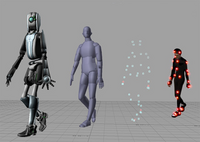
Photo from wikipedia
CONTEXT Simulation-based education (SBE) has demonstrated its acceptability and effectiveness in improving ultrasound training. Because of the high cost of its implementation (investment in equipment and supervision), a pragmatic assessment… Click to show full abstract
CONTEXT Simulation-based education (SBE) has demonstrated its acceptability and effectiveness in improving ultrasound training. Because of the high cost of its implementation (investment in equipment and supervision), a pragmatic assessment of the transfer of skills learned in SBE to clinical practice and the identification of its optimal scheduling conditions have been requested to optimize its input. OBJECTIVES To quantify the long-term impact of simulation-based education (SBE) on the adequate performance of ultrasound fetal biometry measurements (I). The secondary objective was to identify the temporal patterns that enhanced SBE input in learning (II). METHODS Trainees were arbitrarily assigned to a 6-month course in obstetric ultrasound with or without an SBE workshop. In the SBE group, the workshop was implemented 'before' or at an 'early' or a 'late-stage' of the course. Those who did not receive SBE were the control group. The ultrasound skills of all trainees were prospectively collected, evaluated by calculating the delta between OSAUS (Objective Structured Assessment of Ultrasound Skills) scores before and after the course (I). Concomitantly, the accuracy of trainees' measurements was assessed throughout the course by verifying their correlation with the corresponding measurements by their supervisors. The percentage of trainees able to perform five consecutive sets of correct measurements in the control group and in each SBE subgroup were compared (II). RESULTS The study included 61 trainees (39 SBE and 22 controls). Comparisons between groups showed no significant difference in the quantitative assessment of skill enhancement (difference in the pre- and post-internship OSAUS score: 1.09 ± 0.87 in the SBE group and 0.72 ± 0.98 in the control group) (I). Conversely, the predefined acceptable skill level was reached by a significantly higher proportion of trainees in the 'early' SBE subgroup (74%, compared with 30% in the control group, P<0.01)(II). CONCLUSIONS The quantitative assessment does not support the existence of long-term benefits from SBE training, although the qualitative assessment confirmed SBE helped to raise the minimal level within a group when embedded in an 'early' stage of a practical course.
Journal Title: Journal of gynecology obstetrics and human reproduction
Year Published: 2021
Link to full text (if available)
Share on Social Media: Sign Up to like & get
recommendations!